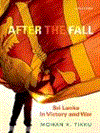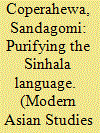| Srl | Item |
| 1 |
ID:
144312


|
|
|
|
|
| Publication |
New Delhi, Oxford University Press, 2016.
|
| Description |
xix, 308p.hbk
|
| Standard Number |
9780199463503
|
|
|
|
|
|
|
|
|
|
|
|
Copies: C:1/I:0,R:0,Q:0
Circulation
| Accession# | Call# | Current Location | Status | Policy | Location |
| 058622 | 954.93032/TIK 058622 | Main | Withdrawn | General | |
|
|
|
|
| 2 |
ID:
115048


|
|
|
|
|
| Publication |
2012.
|
| Summary/Abstract |
This paper provides a detailed account of the socio-political dynamics of the campaign for Sinhala language purism in the 1930s and early 1940s, and re-evaluates the impact of the Hela (pure Sinhala) movement of Munidasa Cumaratunga (1887-1944), a language loyalist and the foremost grammarian of the twentieth century, for the renovation of Sinhala language. It explores Cumaratunga's discourse on linguistic purism, its ideological foundations, and the means by which he organized his puristic intervention. As the case of Cumaratunga indicates, his language purism was not undertaken for the mere love of a language. The paper argues that Cumaratunga's Hela language movement was essentially a revolt against the dominant language practices and ideologies of the colonial government, national political leadership, the pirivena and the contemporary literary elite of the time. Ideologically, the Hela notion was designed as an oppositional discourse to the dominant Indo-Aryan linguistic discourse in the 1930s, and aimed to locate the Hela language at the apex of colonial language hierarchy. Exploring Cumaratunga's perceptions of language this paper demonstrates linguistic purism as a type of language reform which aimed at the formation of the ethno-linguistic uniqueness of the Sinhalese and the politicization of the Sinhala language in the early 1940s.
|
|
|
|
|
|
|
|
|
|
|
|
|
|
|
|